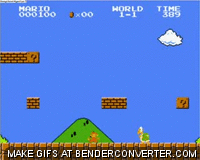Clever of Miyamoto to specifically reference Popeye here. His seminal 1981 arcade game that ushered in a new era for the industry, Donkey Kong, began life as a Popeye game. When Nintendo couldn't acquire the license to use the characters, Popeye became Jumpman (later renamed Mario) and Bluto became Donkey Kong.GAME INFORMER: Time and again, Bowser kidnaps Peach. Why do Mario and Peach still race go-karts and play tennis with him?SHIGERU MIYAMOTO: If you're familiar with things like Popeye and some of the old comic characters, you would oftentimes see this cast of characters that takes on different roles depending on the comic or cartoon. They might be businessman in one [cartoon] or a pirate in another. Depending on the story that was being told, they would change roles. So, to a certain degree, I look at our characters in a similar way and feel that they can take on different roles in different games. It's more like they're one big family, or maybe a troupe of actors.
When you think about Miyamoto's "troupe of actors" comment, it's really been there in the franchise all along. And not just in the figurative sense that gives arch-rivals excuse to play golf and throw parties together. The Mario series is literally a theatrical production.
The first hint is death. Starting with Mario Bros. in 1983, Mario didn't actually die--instead, he simply fell off the stage. In an animation that has since become iconic, the Mario sprite actually came unglued from the environment of the game and fell outside the gameworld. Is this breaking the fourth wall? Perhaps it was a way to explain why one man could have multiple "lives": he wasn't actually dying. Like a long-running theatrical production, he was just doing another run-through of the same scene.
There have been blatant hints sprinkled throughout the series, getting less and less subtle with each subsequent title.
In Super Mario Bros. 2, Nintendo introduced a character selection screen that took place behind curtains:
With Super Mario Bros. 3, the entire title screen was a play:
In Paper Mario, the RPG interpretation of the Mario universe revolved around "battles" staged at a theater, complete with applauding audience members (fully realized here in the sequel, The Thousand-Year Door):
Not only are Mario, Luigi, and Bowser familiar to video game audiences, but most of the bit-role characters are as well. From Koopa Troopas to Shy Guys to Bullet Bills, the Mario franchise has built up a huge stable of otherwise inconsequential minions that fans know and love. No other series in gaming has accomplished this feat. Because of Miyamoto's "troupe of actors" approach in which characters recur in different roles, even casual gamers know what a Goomba is.
But are all Mario's roles created equal? There was another answer in the interview that perked my ears up:
I love this idea that Dr. Mario was a strange role even for the character's creator. This reminds me of films where you see actors cast against type in a role they don't quite fit--like Robin Williams in horror movies. The fact that Williams comes from a comedy background makes the horror that much more creepy. With Mario, the fact that he's normally a working-class guy means a role as a doctor doesn't quite ring true. Miyamoto himself gets the impression Dr. Mario isn't quite "legitimate." After all, all he seems to do is pop pills!GI: Mario has been a boxing referee, a doctor, an Olympian, and a carpenter. Are all these official careers in Mario lore? If he has a medical degree, why does he continue his plumbing business?MIYAMOTO: There's really only one rule in terms of the things that Mario does. Generally, it's that he's more on the blue-collar side. He's hard-working, and certainly much more physical in nature. So, I think that a doctor is sort of an unexpected and perhaps unbelievable role for Mario. Perhaps the Dr. Mario you're thinking of was maybe, in some way, not necessarily legitimate.
With the Mario franchise having an extensive canon of mostly self-contained stories, Miyamoto tells us there's no overarching plotline at all. In fact, perhaps the events of these games aren't happening at all--they're simply all part of stories told by a jolly troupe of performers. It's as if... Mario is a fictional character.
Is this breaking the fourth wall? Is Mario acknowledging he's in a game? This medium hasn't quite learned how to convey gripping plots, but designers like Miyamoto have forged the way for memorable characters. With the same ones in each game, the ensemble cast becomes familiar to us. It's like actors you see onstage or in film. You know Meryl Streep isn't really Julia Child or Margaret Thatcher, but you like the cut of her jib so you'll go see anything she's in anyway.
Mario is Meryl Streep.



Mario Party 2 (and possibly the rest of the series also) takes this even further as well. Its intro is complete with a visible stage, Toad as a narrator, etc. And of course, each game board is themed and the players and other characters dress up in costumes (sheriffs vs. outlaws in the Western board, for example).
ReplyDeleteThe whole Mario Party series seems to capitalize on this!
Delete